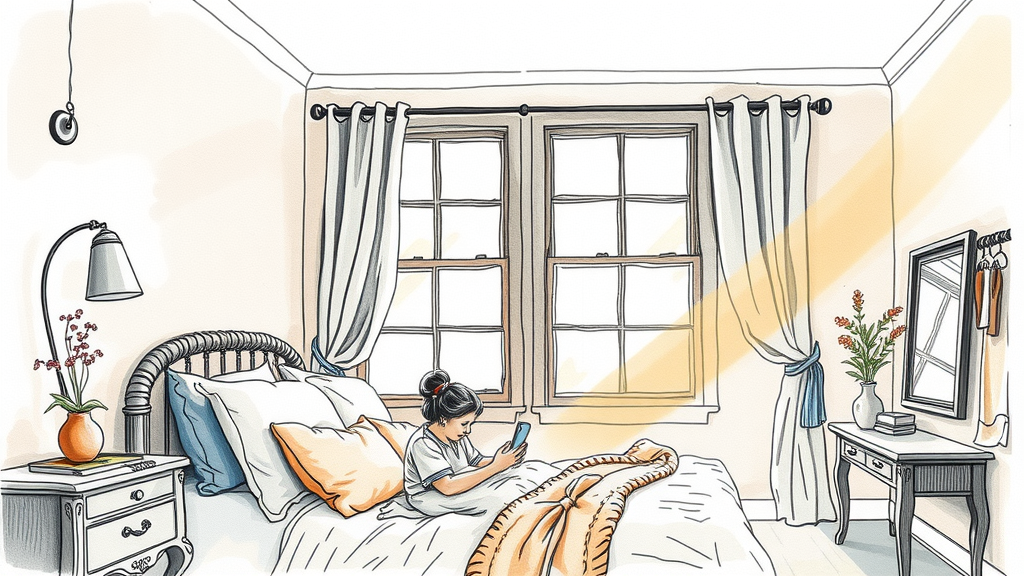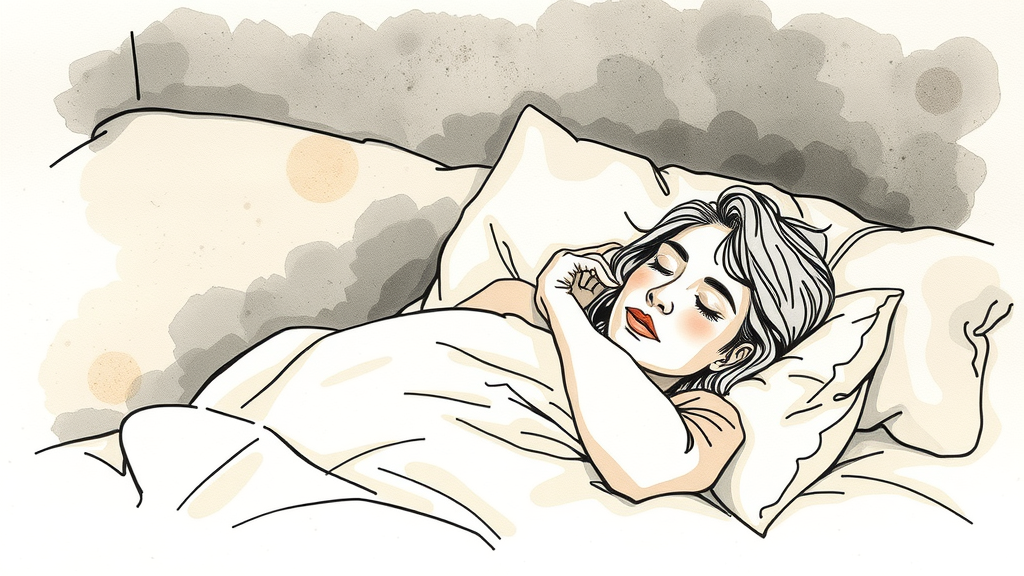· undefined · Health Guides · 7 min read
The Ultimate Guide to CBTI Sleep Therapy for People with Chronic Pain
Discover how CBTI offers drug-free insomnia relief and better sleep for chronic pain sufferers. Learn effective sleep therapy strategies.

Introduction: Reclaiming Sleep from Chronic Pain
Chronic pain affects millions, severely impacting daily life and sleep, often leading to insomnia. This creates a vicious cycle: pain disrupts sleep, and poor sleep intensifies pain. If you live with chronic pain and sleep disturbances, you know this profound impact. While medication offers temporary relief, it rarely addresses root causes. This guide introduces Cognitive Behavioral Therapy for Insomnia (CBTI), an evidence-based, drug free sleep treatment. CBTI empowers individuals to regain control over their sleep, offering sustainable insomnia relief by targeting perpetuating thoughts, feelings, and behaviors. It’s about achieving restorative sleep, even amidst chronic pain.
The Vicious Cycle: Pain, Sleep, and Insomnia
The relationship between chronic pain and sleep is bidirectional. Chronic pain directly impairs sleep:
- Difficulty falling asleep: Discomfort prevents relaxation.
- Frequent awakenings: Pain spikes or constant ache fragment sleep.
- Non-restorative sleep: Sleep is often shallow, unrefreshing.
- Medication side effects: Some pain drugs alter sleep architecture.
Conversely, poor sleep worsens pain:
- Lowered pain threshold: Sleep deprivation increases pain sensitivity.
- Increased inflammation: Lack of sleep can promote systemic inflammation.
- Impaired pain modulation: Body’s natural pain relief systems function poorly.
- Psychological toll: Frustration and anxiety from sleeplessness intensify both conditions.
Breaking this cycle is paramount. A targeted sleep therapy like CBTI offers a potent solution.
What is Cognitive Behavioral Therapy for Insomnia (CBTI)?
Cognitive Behavioral Therapy for Insomnia (CBTI) is the leading drug free sleep treatment for chronic insomnia. Unlike sleeping pills, CBTI addresses underlying behavioral and cognitive factors that sustain sleep difficulties. It’s a structured, short-term (typically 4-8 sessions) program delivered by a trained therapist or via guided online modules.
CBTI’s core premise: insomnia is often maintained by learned behaviors and unhelpful thought patterns (e.g., worrying in bed, trying too hard to sleep). CBTI teaches identification and modification of these patterns, replacing them with sleep-promoting habits. This comprehensive sleep therapy empowers individuals for long-term insomnia relief. As a drug free sleep treatment, it’s ideal for those seeking to reduce medication reliance.
Why CBTI is Ideal for Chronic Pain Sufferers
CBTI offers unique advantages for individuals managing chronic pain:
- Addresses Root Causes: CBTI targets behavioral/cognitive factors perpetuating insomnia, regardless of pain intensity, breaking negative sleep associations.
Drug Free Sleep Treatment: Avoids side effects, interactions, or dependence common with sleep medications, crucial for patients already on multiple drugs. It offers sustainableinsomnia reliefwithout added pill burden.- Empowerment: CBTI provides tools for self-management of sleep, fostering a sense of control that can positively influence pain perception.
- Reduces Pain Catastrophizing: Cognitive restructuring challenges negative thoughts about pain and its sleep impact, reducing anxiety.
- Improves Pain Tolerance & Functioning: Better sleep enhances mood, energy, and resilience, improving coping with pain and daily activities. For those caring for others who might also suffer from sleep issues due to stress or pain, strategies are available to support their rest, similar to those explored in guides like the ultimate guide to CBTI for caregivers.
- Sustainable Results: Skills learned are enduring, providing a lifelong toolkit for managing sleep disturbances, even during pain flares.
Key Components of CBTI for Insomnia Relief
CBTI combines several evidence-based techniques:
Sleep Restriction Therapy (SRT)
Temporarily limits time in bed to consolidate sleep and build a stronger sleep drive. By intentionally increasing sleep deprivation, it boosts sleep efficiency. Time in bed is gradually extended as sleep improves.
Stimulus Control Therapy
Re-establishes the bed and bedroom as cues for sleep and intimacy only. Key rules: go to bed only when sleepy; leave bed if awake for 20+ minutes; use bed exclusively for sleep and sex; maintain a consistent wake-up time daily.
Cognitive Restructuring
Addresses unhelpful thoughts and beliefs about sleep and pain (e.g., “I’ll never sleep with this pain”). It teaches identifying and replacing distorted thoughts with realistic ones, reducing pre-sleep anxiety.
Sleep Hygiene Education
Supports core CBTI by promoting healthy sleep habits: consistent schedule, ideal sleep environment, avoiding evening stimulants, and regular physical activity (not near bedtime). Even high-performing individuals, like athletes using CBTI to optimize recovery and sleep, demonstrate the broad applicability of these techniques in managing physical challenges for better rest.
Relaxation Techniques
Calms the nervous system and reduces pain-related tension. Includes Progressive Muscle Relaxation (PMR), diaphragmatic breathing, mindfulness, and guided imagery, preparing the body for sleep.

Navigating the CBTI Journey with Chronic Pain
Embarking on CBTI alongside chronic pain requires patience and a supportive therapist.
1. Finding a Qualified Therapist: Seek licensed professionals with CBTI and, ideally, chronic pain expertise. Telehealth expands access.
2. Initial Assessment: A thorough sleep history and pain evaluation inform a tailored CBTI protocol.
3. The Process: Typically 4-8 weekly/bi-weekly sessions, involving “homework” like sleep diaries and behavioral practice. Consistency is vital. Understanding how different groups manage sleep with CBTI can be insightful; for example, the unique challenges faced by seniors seeking better sleep through CBTI often share common themes of physical discomfort affecting rest.
4. Adapting for Chronic Pain: A skilled therapist adjusts CBTI for pain, potentially modifying sleep restriction or emphasizing specific relaxation. This ensures the drug free sleep treatment integrates effectively with your overall pain management.
5. Patience and Persistence: CBTI isn’t a quick fix. Initial challenges like temporary increased fatigue during sleep restriction are normal. Stick with the program; long-term insomnia relief is achievable.
Realizing the Benefits: Beyond Just Sleep
CBTI’s impact for chronic pain sufferers extends beyond insomnia relief. Improved sleep directly leads to an enhanced ability to cope with pain. Pain tolerance increases, and emotional distress often diminishes. While pain may persist, its daily impact becomes more manageable.
As a drug free sleep treatment, CBTI avoids medication side effects, leading to clearer cognitive function and sustained energy. Concentration, memory, and decision-making improve.
Mood and emotional well-being significantly enhance. CBTI helps alleviate co-occurring anxiety and depression, fostering a more positive outlook. This comprehensive sleep therapy empowers you to reclaim aspects of life lost to pain and sleeplessness, improving overall quality of life.
Conclusion: Embracing a Restful Future
Living with chronic pain and insomnia is overwhelming. However, Cognitive Behavioral Therapy for Insomnia (CBTI) offers a powerful, drug free sleep treatment for their complex interplay. By systematically targeting unhelpful thoughts and behaviors, CBTI empowers you to break the vicious cycle of sleepless nights and pain-filled days.
This evidence-based sleep therapy provides lifelong strategies for sustainable insomnia relief. It requires commitment, but the rewards—improved sleep quality, enhanced pain management, better mood, and greater well-being—are transformative. If you seek to reclaim your rest despite chronic pain, explore CBTI. It’s an investment in your health for lasting relief and control over your sleep and life.
Frequently Asked Questions About CBTI and Chronic Pain
Q1: Is CBTI painful or difficult for chronic pain sufferers?
A1: While initial challenges exist (e.g., sleep restriction), CBTI is not inherently painful. Therapists adapt strategies for pain levels, aiming for gradual sleep improvement which aids pain management.
Q2: How long does it take for CBTI to provide insomnia relief?
A2: Many individuals see improvements within 4-8 weeks. Lasting insomnia relief comes with consistent practice over several months.
Q3: Can CBTI be a drug free sleep treatment if I’m on pain medication?
A3: Yes. CBTI is a distinct, drug free sleep treatment focusing on behavioral changes. It doesn’t interfere with pain medications and can be implemented alongside your current regimen.
Q4: Do I need to stop my pain medication to start CBTI?
A4: No. CBTI complements existing treatments. Inform your therapist about medications; any changes must be physician-guided.
Q5: Where can I find a qualified CBTI therapist?
A5: Seek licensed professionals through your doctor, organizations like SBSM/AASM, or sleep medicine departments. Online CBTI programs are also increasingly available.
Assess Your Sleep Quality Today
Take our My Sleep Health Score assessment to get personalized insights about your sleep patterns and discover how CBT-I can help you achieve better sleep.

Don Schmidt
15+ years of experience in sleep therapy and Cognitive Behavioral Therapy for Insomnia (CBT-I). Passionate about connecting individuals struggling with sleep disorders to evidence-based, non-medical treatment solutions. Author of hundreds of articles and comprehensive guides on sleep health, CBT-I techniques, and overcoming insomnia. When not helping clients achieve better sleep, you can find me hiking with my family and dogs or enjoying a good book.
Ready to connect with a provider?
Allow us to connect you with a provider who can help.



